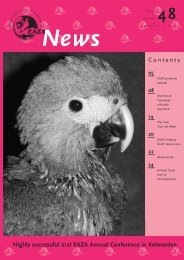EAZA Tiger Campaign extended to 2004 Contents - European ...
EAZA Tiger Campaign extended to 2004 Contents - European ...
EAZA Tiger Campaign extended to 2004 Contents - European ...
Create successful ePaper yourself
Turn your PDF publications into a flip-book with our unique Google optimized e-Paper software.
major long term funding partners in this multi-species conservation<br />
and recovery programme for one of the globally<br />
most endangered ‘biodiversity hotspots’ – the Central<br />
Philippine islands.<br />
More partner zoos needed<br />
While expansion of breeding programmes for Visayan warty<br />
pigs and Panay cloud rats from the Philippines <strong>to</strong> Europe<br />
are planned for the immediate future, the longest established<br />
of these programmes – the Philippine spotted deer<br />
programme – is now at a critical point: with twelve zoos<br />
now participating and the ‘new’ animals imported in<br />
2001 adding more genetic diversity <strong>to</strong> the gene pool,<br />
the programme urgently needs more partner zoos.<br />
Philippine spotted deer are relatively easy <strong>to</strong> maintain in<br />
zoos and provide few management problems. Unlike many<br />
other deer, however, they need heated winter quarters in<br />
Northern and Central Europe and, again, unlike many other<br />
deer, females can be aggressive <strong>to</strong> each other. Breeding<br />
herds of up <strong>to</strong> five or six females are possible, but usually<br />
only by building up numbers from a founder female and her<br />
daughters and granddaughters. Such female groups may be<br />
stable for years, but sudden aggression directed against one<br />
particular female, requiring its separation, or restructuring<br />
of herds, can occur. It is thus desirable <strong>to</strong> find more partners<br />
for the programme who can provide more than one<br />
enclosure for the species. This will reduce the need <strong>to</strong> move<br />
animals between partner zoos, in turn reducing unnecessary<br />
stress on the animals – and the programme coordina<strong>to</strong>r!<br />
Conservation<br />
On the positive side, enclosure size can be smaller than<br />
for many other deer species, and as this species is not a<br />
very good jumper, fences can be lower than for most other<br />
similar-sized deer.<br />
Partner zoos <strong>to</strong> the programme are expected <strong>to</strong> make<br />
a one-off or yearly financial contribution <strong>to</strong> continuation<br />
and expansion of conservation activities in the Philippines.<br />
However, no fixed amount has been set; this will be<br />
negotiated with each partner zoo individually based on<br />
the partner zoo’s financial resources and desire <strong>to</strong> help.<br />
Participation of each new zoo will have <strong>to</strong> be endorsed by<br />
the Wildlife Authorities of the Philippines (all deer and their<br />
progeny are owned by the government of the Philippines),<br />
requiring a waiting period of a few months before animals<br />
can be sent <strong>to</strong> a new partner zoo.<br />
Zoos interested in partnering in this programme,<br />
please contact Jean-Marc Lernould<br />
(jean-marc.lernould@hrnet.fr) or Jens-Ove<br />
Heckel (jens-ove.heckel@landau.de).<br />
Pho<strong>to</strong>: Rob Doolaard/IZP<br />
Pho<strong>to</strong>: Jean-Marc Lernould/Mulhouse Zoo<br />
<strong>EAZA</strong> News 43 – 2003<br />
13<br />
July - August - September

















